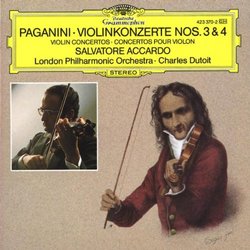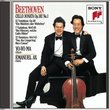| All Artists: Niccolo Paganini, Charles Dutoit, London Philharmonic Orchestra Title: Paganini: Violin Concertos Nos.3 & 4 Members Wishing: 0 Total Copies: 0 Label: Deutsche Grammophon Release Date: 10/25/1990 Genre: Classical Styles: Forms & Genres, Concertos, Instruments, Strings Number of Discs: 1 SwapaCD Credits: 1 UPC: 028942337022 |
Search - Niccolo Paganini, Charles Dutoit, London Philharmonic Orchestra :: Paganini: Violin Concertos Nos.3 & 4
 | Niccolo Paganini, Charles Dutoit, London Philharmonic Orchestra Paganini: Violin Concertos Nos.3 & 4 Genre: Classical
|
Larger Image |
CD DetailsSimilar CDs
|
CD ReviewsConcerto No.3 contains more pyrotechnics than any of the oth Tom Brody | Berkeley, CA | 04/19/2010 (5 out of 5 stars) "This compilation contains two of Paganini's six violin concertos. In my opinion, your first purchase should be a disc with Violin Concerto No.2, because this one contains the famous tune, La Campanella. The soloist, Salvatore Accardo, has at least 150 recordings, according to the Amazon.com web site.
CONCERTO No. 3. ALLEGRO begins with an orchestral pizzicato motif. A jaunty oboe begins a happy tune at 40 seconds into the piece. At 2 minutes, 5 seconds, the jaunty oboe returns with its cocky little tune. At 3 min, 30 sec, comes a dramatic descending episode featuring the full orchestra. At 4 min, 20 sec, we are treated to a lively violin solo punctuated by orchestral pizzicato thumps. The ALLEGRO movement is distinguished by its multitude of special effects from Mr.Accardo's violin: (1) The bow bouncing up and down on a string while bowing; (2) A note changing to another note, by way of a glissando; (3) Violin playing in the extreme upper register, so high that only a dog can hear; (4) Pizzicato episodes; and (5) An almost indescribable special effect that I call a "jiggley-slinky." ADAGIO. This movement also begins with an orchestral pizzicato. The violin plays mainly in the lower register. An orchstral pizzicato goes, "Tra-dah-dah-dah." There is no real tune or melody in this movement. POLACCA. This movement starts out sounding like music for a contra dance. From time to time, there is a brief pizzicato motif that sounds like crackling fireworks. In the entire CONCERTO No. 3, there is no real melody or tune that a layperson could distinguish or hum. However, I very much like the ALLEGRO movement because of the continual array of imaginative posturings by the violin. CONCERTO No. 4. ALLEGRO begins with a distinctive tune, embellished with a peppering of horn toots, and pizzicato string plucks. The solo violin makes its entrance at 3 minutes and 20 seconds. But for the next few minutes, there is no discernable tune to speak of. At 7 min, 20 sec, there is a clever build-up and climax. At 8 min, 10 sec, there is an attractive descending motif (I like descending motifs). This intriguing descending motif is repeated two minutes later, and yet again at 11 min, 40 sec. At 11 min, 10 sec, there is an attractive jiggley-wiggly motif. At 13 min, 40 sec, there is a pizzicato display, followed by an eerie display of ultra-high notes, a swooping glissando, squiggly-jiggly motifs, and another glissando. ADAGIO begins like a Mahlerian funeral march. The orchestra provides a pizzicato background. At 4 minutes, the sound level picks up, involving horns and drums. All along, the orchestral pizzicato continues. At 5 min, 40 sec, we are again subjected to the brief storm of horns and drums. In RONDO, the solo violin provides a little romping tune, reminiscent of Gilbert & Sullivan's THE FLOWERS THAT BLOOM IN THE SPRING, TRA-LA, HAVE NOTHING TO DO WITH THE KING. At 3 minutes, there is an extended part where the violin plays two notes at once, in the manner of a violin duet. On three occasions, we are treated to an intriguing descending motif (I like descending motifs). The motif of FLOWERS THAT BLOOM IN THE SPRING regurns, and stays with us for a few mintues. From 8 minutes on, comes an intriguing violin episode, sounding like space aliens in flying saucers, where the space alien attack is interrupted at various points by a domestic-sounding 3-note horn toot motif. The space alien motif seems especially suited for the soundtrack of the classic film, THE DAY THE EARTH STOOD STILL. CONCLUSION. More information on Paganini can be found in a book, NICOLO PAGANINI by Stephan Stratton (1907). The book is available from Amazon.com. It is also provided by Google." |

 Track Listings (6) - Disc #1
Track Listings (6) - Disc #1
